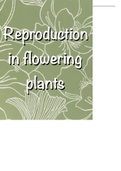Summary
Summary Reproduction in flowering plants Gr 11 & Gr 12 IEB & DBE bio notes
- Course
- Institution
This document contains detailed explanations on the following relating to the IEB and DBE topic of reproduction in flowering plants, specifically: Asexual reproduction in plants Natural asexual reproduction types Artificial asexual reproduction Sexual reproduction in flowering plants Stru...
[Show more]



